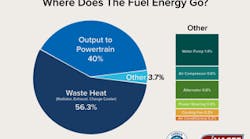NASHVILLE. Switching from belt- or gear-driven engine accessories to variably driven ones has the potential to reduce heavy-truck fuel consumption by 3% to 5%, according to the latest Confidence Report released by the North American Council for Freight Efficiency (NACFE) and the Carbon War Room. However at this stage of development, “variable engine driven accessories present relatively small opportunities for gains in fuel efficiency, but they may provide better payback with further development,” said Michael Roeth, NACFE executive director and IdeaXchange columnist for Fleet Owner.
Introduced at the annual Technology and Maintenance Council meeting, the report was the 15th report issued by the two groups as part of their efforts to double freight efficiency by providing objective evaluations of technology and operating strategies.
The newest report examined eight technologies that are all currently in development including 2-speed cooling fans, variable speed water pumps, clutched air compressors, high-efficiency alternators, smart air dryers, dual displacement power steering pumps, electrically driven A/C compressors and other electrically driven accessories.
The research team interviewed component manufacturers, truck and engine builders, teams involved in the various Super Truck projects, the Dept. of Energy and fleets “in an effort to provide a foundational understanding” of the eight new accessory technologies, some of which might become part of efforts to meet upcoming greenhouse gas emissions standards for heavy trucks.
At the current state of development, the conclusion is that “the fuel economy gains are pretty modest and could even decline” as fleets move to reduce operating engine speeds with downspeeding powertrains,” Roeth said. Fleets are concerned about reliability of new accessory system that add complexity, and the payback on investment in those systems from fuel savings “is insufficient for high levels of adoption at present,” he noted.
Despite that conclusion, the report urges fleets to continue reviewing variable engine-driven accessories and for manufacturers to continue development work. Current work on high voltage and waste-heat recovery systems could potentially lead to improved payback, and greenhouse gas benefits might also drive future adoption, Roeth said.




